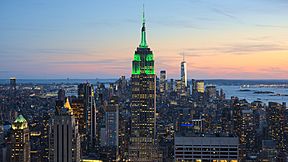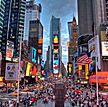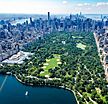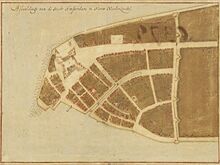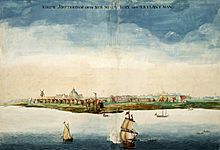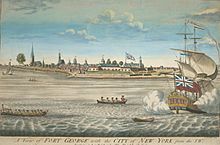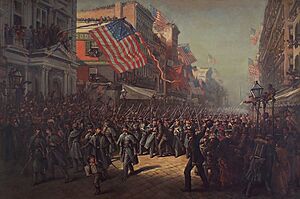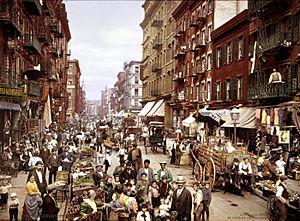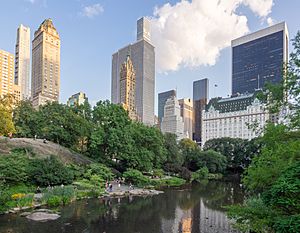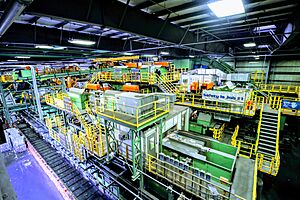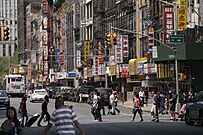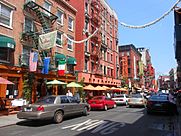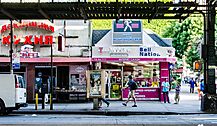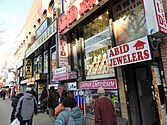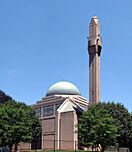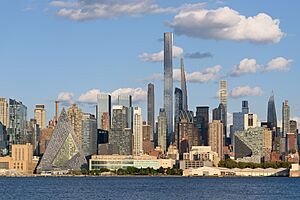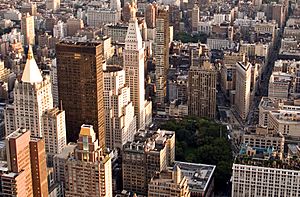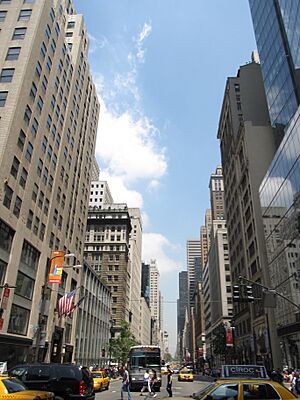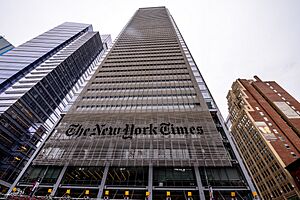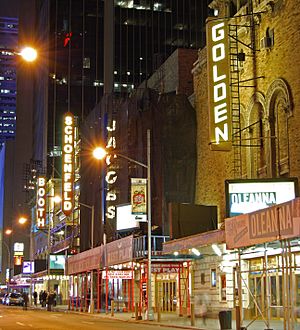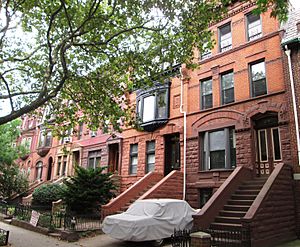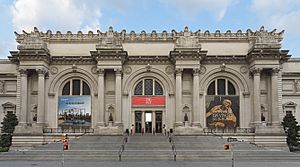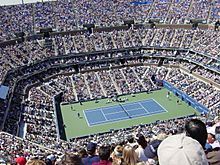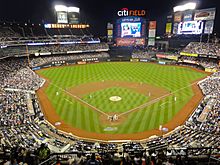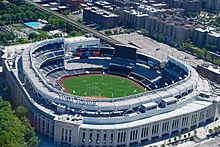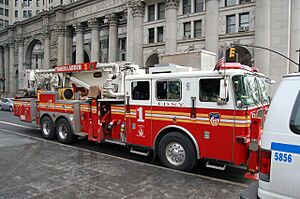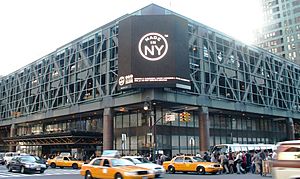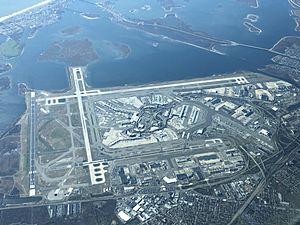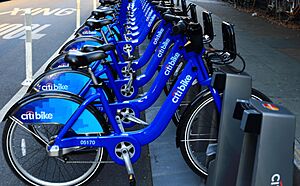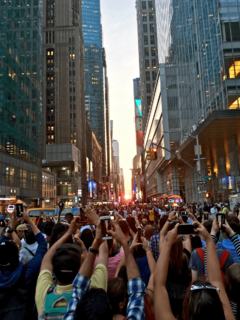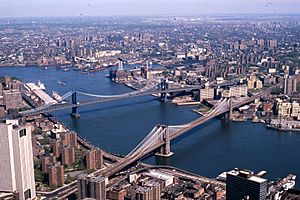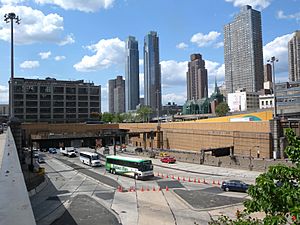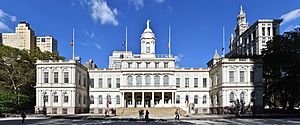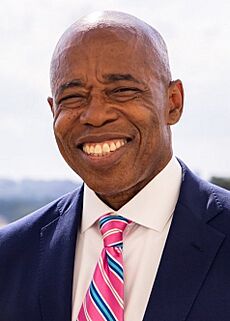New York City facts for kids
Quick facts for kids
New York
|
|||||
|---|---|---|---|---|---|
|
Midtown Manhattan with the Empire State Building (center) and Lower Manhattan with One WTC (background)
|
|||||
|
|||||
| Nicknames:
The Big Apple, The City That Never Sleeps, Gotham, and others
|
|||||
| Country | |||||
| State | |||||
| Settled | 1624 | ||||
| Consolidated | 1898 | ||||
| Named for | York, England (through James, Duke of York) |
||||
| Constituent counties (boroughs) | |||||
| Government | |||||
| • Type | Strong mayor–council | ||||
| • Body | New York City Council | ||||
| Area | |||||
| • Total | 472.43 sq mi (1,223.59 km2) | ||||
| • Land | 300.46 sq mi (778.18 km2) | ||||
| • Water | 171.97 sq mi (445.41 km2) | ||||
| Highest elevation | 401 ft (122 m) | ||||
| Lowest elevation | 0 ft (0 m) | ||||
| Population
(2020)
|
|||||
| • Total | 8,804,190 | ||||
| • Estimate
(2024)
|
8,478,072 | ||||
| • Rank | 1st in the United States | ||||
| • Density | 29,302.7/sq mi (11,313.8/km2) | ||||
| • Urban | 19,426,449 | ||||
| • Urban density | 5,980.8/sq mi (2,309.2/km2) | ||||
| • Metro | 20,140,470 | ||||
| Demonym(s) | New Yorker | ||||
| GDP | |||||
| • Total | $1.286 trillion (2023) | ||||
| • Metro | $2.299 trillion (2023) (1st) | ||||
| Time zone | UTC−05:00 (EST) | ||||
| • Summer (DST) | UTC−04:00 (EDT) | ||||
| ZIP Codes |
100xx–104xx, 11004–05, 111xx–114xx, 116xx
|
||||
| Area codes | 212/646/332, 718/347/929, 917 | ||||
| FIPS code | 36-51000 | ||||
| GNIS feature ID | 975772 | ||||
New York, often called New York City (NYC), is the largest city in the United States by population. It sits at the southern tip of New York State on one of the world's biggest natural harbors. The city is made up of five boroughs, which are also counties.
New York is a major global center for finance, business, culture, technology, and entertainment. It is also home to the headquarters of the United Nations, making it important for international diplomacy.
With about 8.48 million people in July 2024, New York City is the most densely populated major city in the U.S. Its wider metropolitan area has over 20.1 million residents. New York City is a top place for people legally moving to the United States. About 800 languages are spoken here, making it the most language-diverse city in the world. In 2021, nearly 3.1 million people living in the city were born outside the U.S.
New York City started as a trading post called Fort Amsterdam by Dutch colonists around 1624. It was named New Amsterdam in 1626 and became a city in 1653. The English took control in 1664 and renamed it New York after the Duke of York. After the American Revolution, it was the U.S. capital from 1785 to 1790. The modern city was formed in 1898 when its five boroughs joined together: Manhattan, Brooklyn, Queens, the Bronx, and Staten Island.
New York City is a huge financial hub, often called the world's most powerful economic city. In 2022, the New York metropolitan area had the largest economy in the world, worth over US$2.16 trillion. This economy is bigger than almost all countries. The city has the world's two largest stock exchanges: the New York Stock Exchange and Nasdaq. New York City is also known for being very expensive, with high rents and the most expensive shopping street, Fifth Avenue. It has the most billionaires and millionaires of any city globally.
Contents
Why New York is Called New York
In 1664, the city was named New York to honor the Duke of York. He later became King James II of England. The Duke's older brother, King Charles II, gave him control of the land that used to be New Netherland. This included the city of New Amsterdam, which the Kingdom of England had taken from the Dutch.
New York City's Past
Early Beginnings
Before Europeans arrived, the New York City area was home to Algonquian tribes, like the Lenape. Their land, called Lenapehoking, included areas like Staten Island, Manhattan, the Bronx, and parts of Long Island.
The first European to visit New York Harbor was Giovanni da Verrazzano in 1524. He claimed the area for France. In 1609, English explorer Henry Hudson rediscovered the harbor while looking for a route to Asia for the Dutch East India Company. He sailed up the river now known as the Hudson.
Hudson claimed the area for the Dutch. By 1614, the Netherlands claimed the region between Cape Cod and Delaware Bay, calling it New Netherland. The first non-Native American person to live in what became New York City was Juan (Jan) Rodriguez. He was a merchant from Santo Domingo who arrived in Manhattan in 1613–14.
Dutch Control
A lasting European settlement was started in 1624 near New York Harbor. This made New York the 12th oldest continuously settled European place in the U.S. mainland. In 1625, work began on Fort Amsterdam on Manhattan Island, which was later called Nieuw Amsterdam.
The colony of New Amsterdam stretched to modern-day Wall Street. A wooden fence was built there in 1653 to protect against attacks. In 1626, the Dutch leader Peter Minuit bought Manhattan Island from the Canarsie Lenape band. The price was "the value of 60 guilders" (about $900 in 2018). A popular story says it was bought for $24 worth of glass beads, but this is not true.
New Amsterdam grew slowly at first. To get more settlers, the Dutch started the patroon system in 1628. Rich Dutchmen who brought 50 colonists would get land and power. This plan did not work very well.
English Control
In 1664, the Dutch leader Stuyvesant gave up New Amsterdam to English troops without a fight. The English renamed it "New York" after the Duke of York. In 1667, the Dutch officially gave up New York to the English in a peace treaty.
However, in 1673, during another war, the Dutch navy took New York back and renamed it "New Orange." But the Dutch soon returned the island to England in November 1674.
New York grew as a trading port in the early 1700s. It became a center for slavery. By 1730, 42% of homes had enslaved Africans. In the 1990s, the African Burying Ground was found in Foley Square. It held 10,000 to 20,000 graves of Africans from colonial times.
In 1754, Columbia University was founded in the city.
American Revolution

The Stamp Act Congress met in New York in October 1765. The Sons of Liberty group formed there and fought with British troops. The Battle of Long Island, the biggest battle of the American Revolutionary War, happened in Brooklyn in August 1776. The British defeated the American army.
After this defeat, the British made New York their main base in North America. The city became a safe place for people loyal to Britain and for enslaved people who escaped to join the British for freedom. When the British left New York in 1783, they took thousands of freed people to new homes.
A large fire in New York in 1776 destroyed about a quarter of the city's buildings.
After the Revolution and Early 1800s
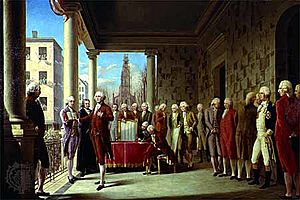
In January 1785, New York City became the national capital. It was the last capital under the Articles of Confederation and the first under the Constitution. George Washington became the first President here in 1789. The first Congress also met here.
In 1790, New York City became the largest city in the nation, passing Philadelphia. Later that year, the capital moved to Philadelphia.
New York City's population grew from 60,000 to 3.43 million during the 1800s. Slavery was completely ended in the state in 1827. The city's growth was also boosted by European immigrants. The Erie Canal, completed in 1825, connected New York's port to the Great Lakes.
Many famous American writers lived in New York in the 1830s and 1840s. Central Park was created in 1857, becoming the first planned park in an American city. The Great Irish Famine brought many Irish immigrants. By 1860, over 200,000 Irish people lived in New York. Germans also made up a large part of the population.
American Civil War
During the American Civil War (1861–1865), new laws about joining the army caused anger. Richer men could pay someone else to go in their place. This led to the Draft Riots of 1863. These riots turned into attacks on New York's wealthy people and then on Black New Yorkers. Rioters burned the Colored Orphan Asylum. At least 120 people were killed, and many Black residents had to flee.
Late 1800s and Early 1900s
In 1886, the Statue of Liberty, a gift from France, was dedicated in New York Harbor. It welcomed 14 million immigrants arriving by ship. The statue is a symbol of freedom and peace for the United States.
In 1898, the City of New York was formed. This happened when Brooklyn, Manhattan, the Bronx, Richmond (Staten Island), and Queens joined together. The New York City Subway opened in 1904, helping to connect the new city. New York became a world center for business and communication in the first half of the 1900s.
In 1911, the Triangle Shirtwaist Factory fire killed 146 garment workers. This led to major improvements in factory safety.
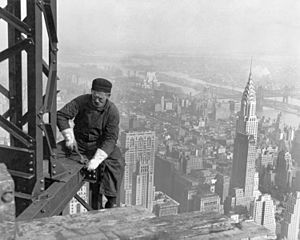
New York City was a main destination for Black Americans during the Great Migration from the South. By 1916, it had the largest urban Black population in North America. The Harlem Renaissance of art and culture grew during this time. Skyscrapers also began to rise, competing for height.
New York City became the most populated urban area in the world in the early 1920s. The wider metropolitan area reached 10 million people in the early 1930s, becoming the first megacity.
After World War II, the economy boomed. The United Nations headquarters was finished in 1952, making New York a global power. The city also became a major center for art.
Recent History
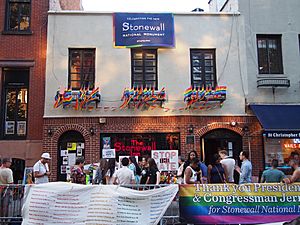
In 1969, the Stonewall riots happened at the Stonewall Inn in Greenwich Village. These protests by the gay community against a police raid are seen as a key event for the modern fight for LGBT rights.
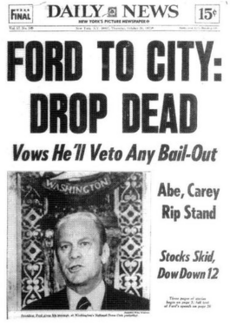
In the 1970s, New York City faced economic problems and rising crime. The city asked the government for money, but President Gerald Ford refused. The city's finances improved in the 1980s, but crime kept rising until the early 1990s.
New York City's population passed 8 million in the 2000 census. New industries like Silicon Alley (tech) grew.
New York City suffered greatly during the September 11 attacks in 2001. Two hijacked planes hit the World Trade Center, causing both towers to fall. This resulted in 2,753 deaths. The area was rebuilt with a new World Trade Center. One World Trade Center is now the tallest skyscraper in the Western Hemisphere.
The Occupy Wall Street protests began in 2011 in Zuccotti Park. These protests against social and economic inequality gained global attention.
Hurricane Sandy hit New York City in October 2012. It caused major flooding and shut down the subway system for days. The storm led to efforts to build defenses against rising seas.
In March 2020, the first case of COVID-19 was confirmed in the city. New York quickly became a global center for the pandemic. By March 2023, over 80,000 people in New York City had died from COVID-19.
City Geography
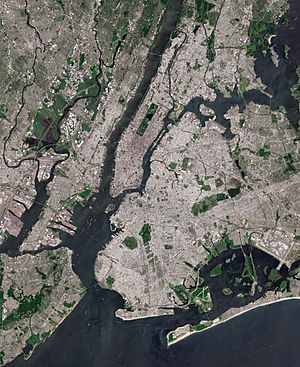
New York City is in the northeastern United States. It is about halfway between Washington, D.C. and Boston. Its location at the mouth of the Hudson River has made it an important trading port. Most of the city is built on three islands: Long Island, Manhattan, and Staten Island.
The Hudson River separates the city from New Jersey. The East River separates the Bronx and Manhattan from Long Island. The Harlem River separates most of Manhattan from the Bronx. The Bronx River is the only completely freshwater river in the city.
The city's land has been changed a lot by people. Land has been added along the waterfronts since Dutch times. This is very clear in Lower Manhattan, where areas like Battery Park City were built.
The city's total area is about 468 square miles. About 302 square miles are land, and 165 square miles are water. The highest point is Todt Hill on Staten Island, which is 401 feet above sea level.
The Five Boroughs
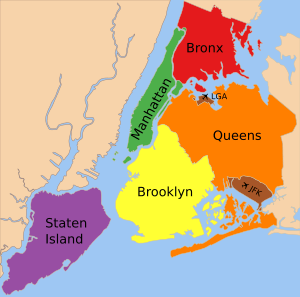
New York City is often called the Five Boroughs. Each borough is also a county in New York State.
- Manhattan (New York County) is the smallest and most crowded borough. It has Central Park and most of the city's skyscrapers. Manhattan is the cultural and financial heart of New York City. It has many major company headquarters and the United Nations headquarters.
- Brooklyn (Kings County), on Long Island, is the most populated borough. It is known for its many cultures and diverse neighborhoods. Downtown Brooklyn is a large central area. Brooklyn has a long beachfront, including Coney Island. It has also become a center for new technology companies and art.
- Queens (Queens County), also on Long Island, is the largest borough by area. It is the most ethnically diverse county in the U.S. Queens is home to Citi Field, where the New York Mets play. It also hosts the annual US Open tennis tournament. Two of the city's busiest airports, John F. Kennedy International Airport and LaGuardia Airport, are in Queens.
- The Bronx (Bronx County) is the northernmost borough and the only one mostly on the U.S. mainland. It is home to Yankee Stadium, where the New York Yankees play. The Bronx Zoo, the world's largest city zoo, is also here. The Bronx is known as the birthplace of hip hop music.
- Staten Island (Richmond County) is the most suburban borough. It is connected to Brooklyn by the Verrazzano-Narrows Bridge. The free Staten Island Ferry connects it to Manhattan. The Staten Island Greenbelt is a large natural area with walking trails.
City Climate
| Weather chart for New York | |||||||||||||||||||||||||||||||||||||||||||||||
|---|---|---|---|---|---|---|---|---|---|---|---|---|---|---|---|---|---|---|---|---|---|---|---|---|---|---|---|---|---|---|---|---|---|---|---|---|---|---|---|---|---|---|---|---|---|---|---|
| J | F | M | A | M | J | J | A | S | O | N | D | ||||||||||||||||||||||||||||||||||||
|
3.6
40
28
|
3.2
42
30
|
4.3
50
36
|
4.1
62
46
|
4
71
55
|
4.5
80
64
|
4.6
85
70
|
4.6
83
69
|
4.3
76
62
|
4.4
65
51
|
3.6
54
42
|
4.4
44
34
|
||||||||||||||||||||||||||||||||||||
| temperatures in °F precipitation totals in inches source: "New York City Weatherbox NOAA" |
|||||||||||||||||||||||||||||||||||||||||||||||
|
Metric conversion
|
|||||||||||||||||||||||||||||||||||||||||||||||
New York City has a humid subtropical climate. This means it has hot, humid summers and chilly, damp winters. The city gets about 49.5 inches of rain each year, spread out evenly. New York gets over 2,500 hours of sunshine annually.
Winters are cold, but the Atlantic Ocean helps keep the city warmer than inland places. Temperatures usually drop to 10°F a few times each winter. Summers are hot and humid, with July averaging 77.5°F. Temperatures can reach over 90°F about 17 days each summer.
Hurricanes and tropical storms are rare. However, Hurricane Sandy in October 2012 caused a lot of damage and flooding. This led to talks about building seawalls to protect the city.
| Month | Jan | Feb | Mar | Apr | May | Jun | Jul | Aug | Sep | Oct | Nov | Dec | Year |
|---|---|---|---|---|---|---|---|---|---|---|---|---|---|
| Record high °F (°C) | 72 (22) |
78 (26) |
86 (30) |
96 (36) |
99 (37) |
101 (38) |
106 (41) |
104 (40) |
102 (39) |
94 (34) |
84 (29) |
75 (24) |
106 (41) |
| Mean maximum °F (°C) | 60.4 (15.8) |
60.7 (15.9) |
70.3 (21.3) |
82.9 (28.3) |
88.5 (31.4) |
92.1 (33.4) |
95.7 (35.4) |
93.4 (34.1) |
89.0 (31.7) |
79.7 (26.5) |
70.7 (21.5) |
62.9 (17.2) |
97.0 (36.1) |
| Mean daily maximum °F (°C) | 39.5 (4.2) |
42.2 (5.7) |
49.9 (9.9) |
61.8 (16.6) |
71.4 (21.9) |
79.7 (26.5) |
84.9 (29.4) |
83.3 (28.5) |
76.2 (24.6) |
64.5 (18.1) |
54.0 (12.2) |
44.3 (6.8) |
62.6 (17.0) |
| Daily mean °F (°C) | 33.7 (0.9) |
35.9 (2.2) |
42.8 (6.0) |
53.7 (12.1) |
63.2 (17.3) |
72.0 (22.2) |
77.5 (25.3) |
76.1 (24.5) |
69.2 (20.7) |
57.9 (14.4) |
48.0 (8.9) |
39.1 (3.9) |
55.8 (13.2) |
| Mean daily minimum °F (°C) | 27.9 (−2.3) |
29.5 (−1.4) |
35.8 (2.1) |
45.5 (7.5) |
55.0 (12.8) |
64.4 (18.0) |
70.1 (21.2) |
68.9 (20.5) |
62.3 (16.8) |
51.4 (10.8) |
42.0 (5.6) |
33.8 (1.0) |
48.9 (9.4) |
| Mean minimum °F (°C) | 9.8 (−12.3) |
12.7 (−10.7) |
19.7 (−6.8) |
32.8 (0.4) |
43.9 (6.6) |
52.7 (11.5) |
61.8 (16.6) |
60.3 (15.7) |
50.2 (10.1) |
38.4 (3.6) |
27.7 (−2.4) |
18.0 (−7.8) |
7.7 (−13.5) |
| Record low °F (°C) | −6 (−21) |
−15 (−26) |
3 (−16) |
12 (−11) |
32 (0) |
44 (7) |
52 (11) |
50 (10) |
39 (4) |
28 (−2) |
5 (−15) |
−13 (−25) |
−15 (−26) |
| Average precipitation inches (mm) | 3.64 (92) |
3.19 (81) |
4.29 (109) |
4.09 (104) |
3.96 (101) |
4.54 (115) |
4.60 (117) |
4.56 (116) |
4.31 (109) |
4.38 (111) |
3.58 (91) |
4.38 (111) |
49.52 (1,258) |
| Average snowfall inches (cm) | 8.8 (22) |
10.1 (26) |
5.0 (13) |
0.4 (1.0) |
0.0 (0.0) |
0.0 (0.0) |
0.0 (0.0) |
0.0 (0.0) |
0.0 (0.0) |
0.1 (0.25) |
0.5 (1.3) |
4.9 (12) |
29.8 (76) |
| Average precipitation days (≥ 0.01 in) | 10.8 | 10.0 | 11.1 | 11.4 | 11.5 | 11.2 | 10.5 | 10.0 | 8.8 | 9.5 | 9.2 | 11.4 | 125.4 |
| Average snowy days (≥ 0.1 in) | 3.7 | 3.2 | 2.0 | 0.2 | 0.0 | 0.0 | 0.0 | 0.0 | 0.0 | 0.0 | 0.2 | 2.1 | 11.4 |
| Average relative humidity (%) | 61.5 | 60.2 | 58.5 | 55.3 | 62.7 | 65.2 | 64.2 | 66.0 | 67.8 | 65.6 | 64.6 | 64.1 | 63.0 |
| Average dew point °F (°C) | 18.0 (−7.8) |
19.0 (−7.2) |
25.9 (−3.4) |
34.0 (1.1) |
47.3 (8.5) |
57.4 (14.1) |
61.9 (16.6) |
62.1 (16.7) |
55.6 (13.1) |
44.1 (6.7) |
34.0 (1.1) |
24.6 (−4.1) |
40.3 (4.6) |
| Mean monthly sunshine hours | 162.7 | 163.1 | 212.5 | 225.6 | 256.6 | 257.3 | 268.2 | 268.2 | 219.3 | 211.2 | 151.0 | 139.0 | 2,534.7 |
| Percent possible sunshine | 54 | 55 | 57 | 57 | 57 | 57 | 59 | 63 | 59 | 61 | 51 | 48 | 57 |
| Average ultraviolet index | 2 | 3 | 4 | 6 | 7 | 8 | 8 | 8 | 6 | 4 | 2 | 1 | 5 |
| Source 1: NOAA (relative humidity and sun 1961–1990; dew point 1965–1984) | |||||||||||||
| Source 2: Weather Atlas
See Climate of New York City for additional climate information from the outer boroughs. |
|||||||||||||
City Parks

New York City has a large park system. These parks are managed by different groups, including the National Park Service and the city's own Parks Department. In 2023, New York City's park system was ranked among the top ten in the U.S. for large cities. This is because of its many parks and how close they are to residents.
Gateway National Recreation Area has over 26,000 acres, mostly in New York City. This park includes salt marshes, wetlands, and islands. It also has parts of the western Rockaway Peninsula, like Jacob Riis Park.
The Statue of Liberty National Monument and Ellis Island Immigration Museum are managed by the National Park Service. Other historic sites in Manhattan include Stonewall National Monument and General Grant National Memorial.
New York City has over 28,000 acres of city parks and 14 miles of public beaches. The largest city park is Pelham Bay Park in the Bronx. The most visited park is Central Park, which had 42 million visitors in 2023.
City Environment
New York City works to reduce its environmental impact. It has a very low rate of greenhouse gas emissions per person. This is partly because so many people use public transportation.
The city's drinking water comes from the protected Catskill Mountains watershed. This water is so clean that it usually does not need special treatment. New York has the largest city water system in the U.S.
New York City is also very walkable. In 2011 and 2015, it was named the most walkable large city in the U.S. The Citi Bike bike-share program started in 2013. Cycling has become very popular, with over 610,000 bike trips daily in 2022.
City Population
| Historical population | ||
|---|---|---|
| Year | Pop. | ±% |
| 1698 | 4,937 | — |
| 1712 | 5,840 | +18.3% |
| 1723 | 7,248 | +24.1% |
| 1737 | 10,664 | +47.1% |
| 1746 | 11,717 | +9.9% |
| 1756 | 13,046 | +11.3% |
| 1771 | 21,863 | +67.6% |
| 1790 | 33,131 | +51.5% |
| 1800 | 60,515 | +82.7% |
| 1810 | 96,373 | +59.3% |
| 1820 | 123,706 | +28.4% |
| 1830 | 202,589 | +63.8% |
| 1840 | 312,710 | +54.4% |
| 1850 | 515,547 | +64.9% |
| 1860 | 813,669 | +57.8% |
| 1870 | 942,292 | +15.8% |
| 1880 | 1,206,299 | +28.0% |
| 1890 | 1,515,301 | +25.6% |
| 1900 | 3,437,202 | +126.8% |
| 1910 | 4,766,883 | +38.7% |
| 1920 | 5,620,048 | +17.9% |
| 1930 | 6,930,446 | +23.3% |
| 1940 | 7,454,995 | +7.6% |
| 1950 | 7,891,957 | +5.9% |
| 1960 | 7,781,984 | −1.4% |
| 1970 | 7,894,862 | +1.5% |
| 1980 | 7,071,639 | −10.4% |
| 1990 | 7,322,564 | +3.5% |
| 2000 | 8,008,288 | +9.4% |
| 2010 | 8,175,133 | +2.1% |
| 2020 | 8,804,190 | +7.7% |
| 2024 est. | 8,478,072 | −3.7% |
New York City is the most populated city in the U.S. In 2020, it had 8,804,190 residents, its highest number ever. More than twice as many people live in New York City as in Los Angeles. The city's population density is very high, making it the densest major city in the U.S.
In 2020, New York City's population was 35.9% White, 22.7% Black, 14.6% Asian, and 28.4% Hispanic or Latino. The city gained 629,000 residents between 2010 and 2020.
New York City is home to people from all over the world. About 36.3% of the city's population was born outside the U.S. Queens is known as the most ethnically and linguistically diverse urban area in the world. New York is the top place for legal immigrants coming to the United States.
Different Cultures and Backgrounds
New York City has many different ethnic groups. The largest groups include people of Dominican, Chinese, Puerto Rican, and Italian backgrounds.
Many immigrants have come to New York throughout its history. No single country or region dominates. Queens has the largest Asian-American population in the U.S. It also has the largest Andean populations.
New York has the largest Chinese population of any city outside Asia. Manhattan's Chinatown is the biggest concentration of Chinese people in the Western Hemisphere. Queens is home to the largest Tibetan population outside Asia.
New York City has the largest European and non-Hispanic white population of any American city. With 960,000 Jewish residents in 2023, New York City has the highest Jewish population of any city in the world.
Religion in the City
Christianity is the largest religion in New York City, with 59% of people following it. The city has the most churches of any city in the world. Catholicism is the largest Christian group.
Judaism is the second-largest religion, with 960,000 Jewish residents in 2023. Almost half of the city's Jewish people live in Brooklyn.
Islam is the third-largest religion, with estimates of 600,000 to 1,000,000 followers. New York City has the most diverse Muslim population of any city in the world.
Other religions include Hinduism, Buddhism, and Sikhism. About 24% of New Yorkers do not identify with an organized religion.
City Economy
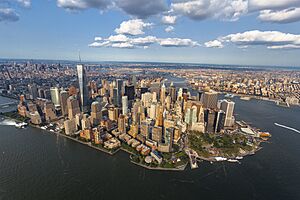
New York City is a global center for business and trade. It is sometimes called the "Capital of the World." The greater New York area has the largest city economy in the world, valued at US$2.16 trillion in 2022. New York is a leader in banking, finance, healthcare, technology, and entertainment.
Many large companies have their main offices in New York City. The city is ranked first globally for attracting money, businesses, and tourists. New York is also a top center for the advertising industry. The city's fashion industry employs about 180,000 people.
In 2022, New York City's total economic output was US$1.053 trillion. Manhattan alone produced 74% of this. New York City has a high cost of living, especially for housing. In 2024, New York City had the most billionaires of any city in the world, with 110.
Wall Street's Role

New York City's most important economic area is its role as a financial center, known as Wall Street. Lower Manhattan is home to the New York Stock Exchange and the Nasdaq. These are the world's largest and second-largest stock exchanges.
Wall Street's financial industry creates a lot of tax money for New York State. New York City is also the biggest global center for trading stocks and bonds. It leads in managing hedge funds and private investments.
Manhattan had over 500 million square feet of office space in 2018. This makes New York City the largest office market in the world. Midtown Manhattan is the largest central business district globally.
Tech and Biotech Growth

New York is a top global technology hub. The city's tech scene has grown a lot since 2003. It now includes areas like artificial intelligence (AI), internet, new media, and biotechnology. Tech companies and jobs are growing fast in New York City.
In 2022, New York City's AI sector received US$483.6 million in investments. In 2023, the city started a plan to create rules for using AI in city government.
The biotechnology sector is also growing. This is thanks to the city's strong scientific research and financial support. In 2011, Cornell University and Technion-Israel Institute of Technology began building Cornell Tech. This $2 billion science school on Roosevelt Island aims to make New York City a top technology capital.
Real Estate Market
New York City real estate is a safe place for global investors. The total value of all property in New York City was US$1.479 trillion in 2017. Fifth Avenue in Midtown Manhattan has the highest retail rents in the world.
New York City has one of the highest costs of living globally. This is made worse by a shortage of housing. In 2023, the average monthly rent for a one-bedroom apartment in Manhattan was US$4,443. The median house price city-wide was over $1 million.
The vacancy rate for apartments was 1.4% in 2023. This was the lowest since 1968 and shows a shortage of available homes.
Tourism in NYC
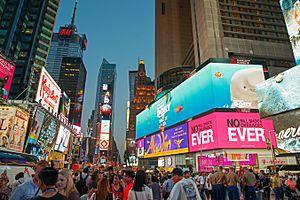
Tourism is a very important industry for New York City. Many people visit the city from around the world. In 2019, a record 66.6 million tourists visited, bringing in $47.4 billion. Visitor numbers dropped during the pandemic but rebounded to 63.3 million in 2023.
Many famous places in New York City are major landmarks. These include the Metropolitan Museum of Art, the Statue of Liberty, the Empire State Building, and Central Park. Times Square is a bright, busy area in the Broadway Theater District. It attracts 50 million visitors each year.
Media and Entertainment

New York City is a global capital for entertainment and digital media. It is a center for advertising, music, newspapers, and publishing. Many of the world's largest media companies are based here.
More than 200 newspapers and 350 magazines have offices in the city. The publishing industry employs about 11,500 people. Two major national newspapers, The Wall Street Journal and The New York Times, are published in New York.
New York City is also a big center for making movies and TV shows. In 2019, it was the second-largest center in the U.S. for this. The city produces about 200 feature films each year.
City Culture
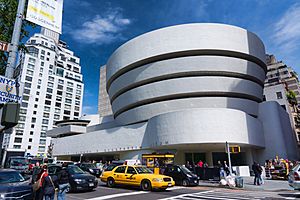
New York City is often the setting for books, movies, and TV shows. It has been called the cultural capital of the world. The city is where many cultural movements began. These include the Harlem Renaissance in art and literature, and hip-hop music.
New York City is known for its fast pace. Its residents are also known for being strong and bouncing back from challenges. In 2021 and 2022, New York was voted the world's most resilient city.
Theater Scene
Manhattan is the main center for American theater. It has Broadway, off-Broadway, and off-off-Broadway shows. Many movie and TV stars started their careers in New York plays.
Broadway theatre is one of the best forms of English-language theater. It is named after Broadway, a main street that crosses Times Square. Forty-one theaters in Midtown Manhattan are called Broadway theatres. The 2022–23 Broadway season had revenues of $1.58 billion. The Tony Awards celebrate excellence in Broadway theater.
New York Accent
The New York area has a special way of speaking called the New York dialect. It is also known as Brooklynese or New Yorkese. This accent is one of the most recognizable in American English. It is known for fast talking. However, with many new immigrants, this traditional accent is not as common as it used to be.
City Architecture
New York has many interesting buildings in different styles and from different times. These range from old Dutch Colonial homes to the modern One World Trade Center.
Manhattan's skyline with its many skyscrapers is a famous symbol of the city. New York City had 6,455 tall buildings in 2019, one of the most in the world.
Many residential areas have elegant brownstone rowhouses and tenements. These were built when the city grew quickly from 1870 to 1930. Stone and brick became popular after a big fire in 1835.
Some neighborhoods have less crowded areas with single-family homes. These can be found in places like Riverdale and Ditmas Park.
Arts and Museums
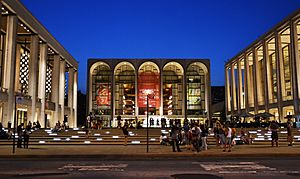
Lincoln Center for the Performing Arts is a major arts center in Manhattan. It is home to groups like the Metropolitan Opera and the New York Philharmonic. The Juilliard School is also there.
New York City has over 2,000 arts and cultural groups and more than 500 art galleries. The city government gives a lot of money to the arts.
Museum Mile is a section of Fifth Avenue with nine museums. These include the Guggenheim and the Metropolitan Museum of Art. The Metropolitan Museum of Art is the largest art museum in the Americas. In 2022, it had 3.2 million visitors.
City Food
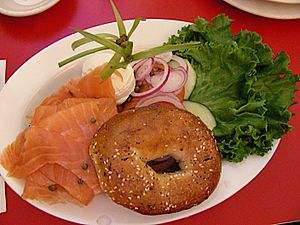
New York City's food culture has many international cuisines. This is because of the city's long history of immigrants. Immigrants from Central and Eastern Europe brought New York-style bagels, cheesecake, and hot dogs. Italian immigrants brought New York-style pizza.
Chinese and other Asian restaurants, sandwich shops, and diners are everywhere. About 4,000 mobile food vendors sell street food like falafel and kebabs. The city has "nearly one thousand of the finest and most diverse haute cuisine restaurants in the world." In 2019, there were 27,043 restaurants in the city.
Fashion World
New York City is a global fashion capital. The fashion industry employs 4.6% of the city's private workers. New York Fashion Week (NYFW) is a big event twice a year. Models show off the latest clothes from designers around the world.
NYFW helps set trends for the global fashion industry. New York's fashion district is in Midtown Manhattan. It is sometimes called Fashion Avenue.
City Parades

New York City is famous for its street parades, mostly in Manhattan. The annual Macy's Thanksgiving Day Parade is the world's largest parade. It starts near Central Park and goes south to the Macy's store. Millions of people watch it in person and on TV.
Other famous parades include the New York City St. Patrick's Day Parade in March and the NYC LGBT Pride March in June. There are also many parades celebrating the independence days of different countries.
Sports in New York
New York City is home to the main offices of major sports leagues. These include the National Football League, Major League Baseball, and the National Basketball Association.
The city has hosted many major professional sports teams. Four of the ten most expensive stadiums ever built are in the New York area.
The city has two Major League Baseball teams: the New York Mets and the New York Yankees. The Yankees have won a record 27 championships. The two teams play against each other in the "Subway Series."
The city's National Basketball Association teams are the New York Knicks and the Brooklyn Nets. The New York Liberty is the city's women's basketball team.
The New York area has three National Hockey League teams. The New York Rangers play in Manhattan. The New York Islanders and New Jersey Devils play in nearby areas.
New York City has two Major League Soccer teams: New York City FC and the New York Red Bulls. New York will be one of the host cities for the 2026 FIFA World Cup.
The annual US Open tennis tournament is held in Queens. The New York City Marathon runs through all five boroughs. It is the world's largest running marathon.
City Resources
Education System
New York City has the largest education system of any city. The New York City Public Schools system is the biggest public school system in the U.S. It serves about 1.1 million students in 1,800 schools. There are also about 900 private schools.
The New York Public Library has the largest collection of any public library system in the U.S. Queens and Brooklyn also have large public library systems.
More than a million students attend over 120 colleges and universities in New York City. The City University of New York (CUNY) system alone has over half a million students. New York City has some of the best higher education institutions in the world.
Many famous private universities are in New York City. These include Columbia University, New York University, and Fordham University. Much of the scientific research in the city is in medicine and life sciences.
Healthcare Services
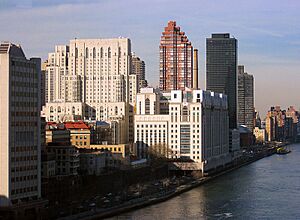
New York City is a center for healthcare and medical training. Over 750,000 people work in the city's healthcare sector. Private hospitals include NewYork-Presbyterian Hospital and Mount Sinai Hospital.
NYC Health + Hospitals (HHC) runs the city's public hospitals and clinics. It is the largest city healthcare system in the U.S. HHC serves 1.4 million patients, including many who do not have insurance.
Bellevue Hospital is the oldest public hospital in the U.S., started in 1736. It is the hospital for world leaders if they need care in New York City.
New York City has laws to help people who need shelter. This means providing safe places to stay and food. Because of this, New York has a lower percentage of people sleeping outside than other cities.
Public Safety
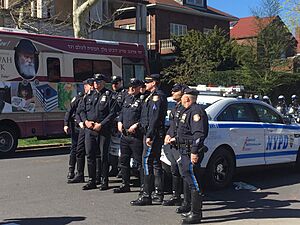
The New York Police Department (NYPD) is the largest police force in the U.S. It has over 36,000 officers. They are often called New York's Finest.
Crime rates in New York City have gone down a lot since the 1990s. Violent crime decreased by over 75% from 1993 to 2005. The number of murders in 2018 was 289, a near 70-year low. In 2023, there were 386 murders, a 12% drop from the year before. New York City has one of the lowest murder rates among the ten largest U.S. cities.
New York City has stricter gun laws than most other U.S. cities. A license is needed to own any firearm.
The Fire Department of New York (FDNY) provides fire protection and emergency medical services. FDNY faces unique challenges, like fighting fires in tall buildings and the subway system.
City Transportation
Public Transit
New York City's public transportation runs 24 hours a day. It accounts for one in every three mass transit users in the country.
Buses
New York City's public bus system is the largest in North America. It also runs 24/7. In 2022, MTA buses served over 483 million trips.
The Port Authority Bus Terminal is the city's main bus station for travel between cities. It is the world's busiest bus station. It serves 250,000 passengers on 7,000 buses each workday.
Trains and Subways
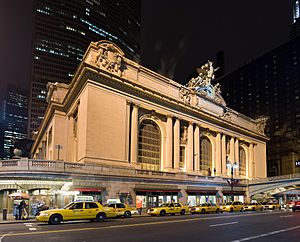
The New York City Subway system is the largest rapid transit system in the world by number of stations. Almost all of New York's subway system is open 24 hours a day. It is the busiest city rail system in the Western Hemisphere.
Public transport is widely used in New York City. In 2005, 54.6% of New Yorkers used mass transit to get to work. This is very different from the rest of the country. New Yorkers spend less on transportation than the national average.
New York City's commuter rail network is the largest in North America. It connects the city to its suburbs. The Long Island Rail Road, Metro-North Railroad, and New Jersey Transit all serve the area. These systems meet at Grand Central Terminal and New York Penn Station.
The Staten Island Railway serves only Staten Island. The PATH train connects Manhattan with New Jersey. Grand Central Terminal is the world's largest train station by number of platforms.
Air Travel
New York's airspace is the busiest in the United States. The three busiest airports in the New York area are John F. Kennedy International Airport, Newark Liberty International Airport, and LaGuardia Airport. These three airports served 127.9 million travelers in 2022.
JFK and Newark Liberty were the busiest and fourth-busiest U.S. airports for international passengers in 2023. LaGuardia Airport has undergone an $8 billion project to replace its old facilities with modern ones.
Ferries, Taxis, and Trams
The Staten Island Ferry is the world's busiest ferry. It carries over 23 million passengers each year between Staten Island and Lower Manhattan. Other ferry systems connect Manhattan to other parts of the city. NYC Ferry was launched in 2017.
New York City's 13,587 yellow taxicabs are the only vehicles allowed to pick up riders on the street. Green boro taxis can pick up rides in Upper Manhattan and the outer boroughs. Ride-sharing services like Uber and Lyft now provide most trips in the city.
The Roosevelt Island Tramway is an aerial tramway that carries 2 million passengers each year. It connects Roosevelt Island to Manhattan.
Cycling in the City
Cycling is becoming more popular in New York City. In 2022, about 61,200 people commuted daily by bicycle. There were 610,000 daily bike trips. New York City had 1,525 miles of bike lanes in 2022. This included 644 miles of protected bike lanes.
Streets and Highways
New York City is known for its busy streets. It has a large network of freeways and parkways. These connect the city's boroughs to each other and to nearby areas. Traffic congestion is common, especially during rush hour.
Congestion pricing in New York City started in January 2025. This program charges drivers to enter parts of Manhattan. It aims to encourage people to use public transit instead. Unlike most of the U.S., turning right on a red light is usually not allowed in New York City.
Bridges and Tunnels
Manhattan and Staten Island are islands. Queens and Brooklyn are on Long Island. The Bronx is on the mainland. Bridges and tunnels connect these areas.
The 14-lane George Washington Bridge connects Manhattan to New Jersey. It is the world's busiest motor vehicle bridge. The Verrazzano-Narrows Bridge is the longest suspension bridge in the Americas.
The Brooklyn Bridge is a city icon. It opened in 1883 and was the first steel-wire suspension bridge. The Queensboro Bridge and Manhattan Bridge are also important. The Throgs Neck Bridge and Whitestone Bridge connect Queens and the Bronx. The Triborough Bridge connects Manhattan, Queens, and the Bronx.
The Lincoln Tunnel carries 120,000 vehicles a day under the Hudson River. It is the busiest vehicle tunnel in the world. The Holland Tunnel was the first mechanically ventilated vehicle tunnel. The Queens–Midtown Tunnel and Brooklyn–Battery Tunnel also help with traffic.
City Government
New York City has a strong mayor–council form of government. The city government is in charge of public education, safety, parks, and water supply.
The City Council has 51 members. The mayor and council members serve four-year terms.
New York City is divided into different court districts. The Criminal Court and Civil Court handle local cases. The New York Supreme Court handles major trials.
City Politics
The city's mayor is Eric Adams, a Democrat. The Democratic Party holds most public offices in the city. As of November 2023, 67% of registered voters were Democrats. New York City has not voted for a Republican presidential candidate since 1924.
New York City is a big source of money for political campaigns. The city sends more tax money to the national and state governments than it gets back in services.
Global Connections
New York City has a program called New York City Global Partners. This program connects New York with other cities around the world. These are called sister cities.
- Africa: Accra, Ghana; Cairo, Egypt; Cape Town, South Africa; Lagos, Nigeria; Johannesburg, South Africa; Nairobi, Kenya
- Asia: Beijing, China; Tokyo, Japan; Hong Kong, China; Seoul, South Korea; Mumbai, India; Singapore
- Australia: Melbourne, Australia; Sydney, Australia
- Europe: Berlin, Germany; London, United Kingdom; Paris, France; Rome, Italy; Madrid, Spain
- North America: Montreal, Canada; Toronto, Canada; Mexico City, Mexico
- South America: Buenos Aires, Argentina; Rio de Janeiro, Brazil; Santiago, Chile
Images for kids
See also
 In Spanish: Nueva York para niños
In Spanish: Nueva York para niños


